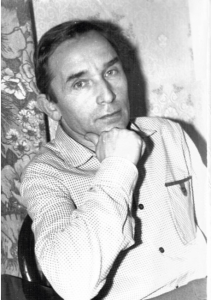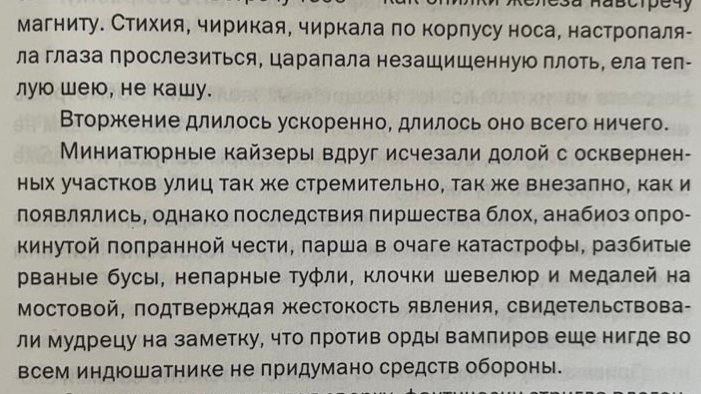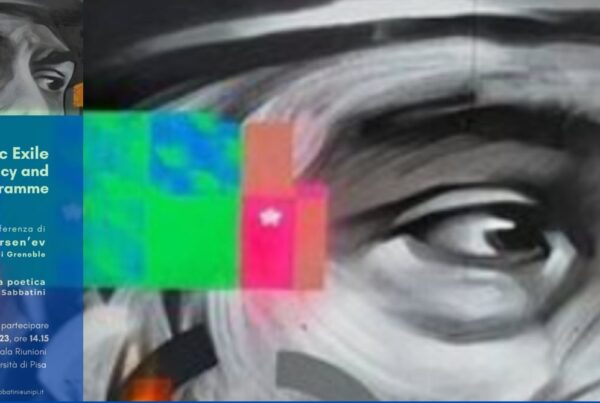
Vladimir Gubin. Source: Kinzhnaia Lavka Pisatelei © 2023
Author: Vladimir Gubin (1934-2003)
Years of writing: 1976-1997
Year of first publication: 1997
Place of publication: Saint Petersburg
Description:
Vladimir Gubin devoted twenty years of his life to writing and refining one text in the conviction that “true literature is a gift, and not a commodity for mass consumption” (Gubin, in Dar 2002: 136). Indeed, after the first draft was printed thanks to another gorozhan, Vladimir Maramzin, in 1984 in the tamizdat magazine “Ėkho”, Gubin never again sought to publish his work in the Soviet Union or abroad. It was through this obstinacy that Gubin affirmed his total and definitive otherness, an ontological refusal to interact with the system, or with the anti-systems the system generated. His closest friends never read his work, it was not circulated even in samizdat, and Gubin remained deliberately invisible, an anonymous Lengaz employee apparently no different from his workmates. His profound belief in his own literary talents was for decades masked by continuous self-denigration. That Gubin never doubted his literary value is testified by an incredulous, almost sarcastic, Sergei Dovlatov in Remeslo [The Craft]: “It’s true, I’m not looking for a publisher. It is useless. But I write. I write for nights on end. And I reach heights I never even dreamed of!” (Dovlatov 2014: 23). It would take first the fall of the USSR, and then the pressure of Oleg Iur’ev to finally bring Gubin’s extraordinary text into the light. However, although it was finally published, Gubin’s masterpiece has never received the critical recognition and popular success it deserves.
The solitary literary activity of Vladimir Gubin, spanning twenty years from the conception of Illarion i Karlik to the completion of its final version, was not only a matter of labor limae, but a way of defining an artistic identity, which was forged in two phases. The first phase was in the 1950s and involved a process of constant and continuous confrontation, evident in the lively and partially published letters Gubin exchanged with David Dar (cf. Dar 2002), who, at times through harsh criticism, helped the young writer free himself from affectation and discover an authentic voice. The second phase, in the 1960s, hinged on Gubin’s encounter with the other Gorozhane with whom he produced two collected works, both with a preface by the aforementioned Dar, which, rejected by the censorship authorities, were left unpublished. As a result of reflections Gubin embarked on during these years, Gubin developed a more mature poetics which came to fruition in the last version of Illarion and Karlik . His was a poetics firmly grounded in a “hatred for silly language” (Gorozhane 1966: 4), and his convictions led to him living privately and writing only for himself. Gubin’s writing is based on a devotion to the “word”, combined with “an indestructible and unquenchable nostalgia for the perfection of the text” (Iur’ev 2014: 139), and is combined with the ethical urgency of surviving in a system that silenced discordant voices. Like other artists of his generation, Gubin sought to repair the divide that separated Russian culture at the beginning of the century from Soviet culture. The complexity and stratification of the Silver Age and modernism prevented the Soviet state from bending the art and literature of this period to suit their own ideological purposes, and early twentieth century culture became a reference point for writers like Gubin seeking to legitimise their own non-Soviet writings and sentiments (cf. Berg 2003: 5). For Gubin, Andrei Belyi’s Maski [Masks, 1932], was an important work in this respect. The almost entirely metricalized novel is an accomplished late incarnation of the poetics of one of the most prominent modernist writers. It hovers between prose and poetry, and it led Gubin to move increasingly towards the metricalization of prose in Illarion and Karlik. In many respects Gubin surpasses Belyi: more than 90% of his text is metrical, but his metrical chains are short and broken, and the metres (mostly ternary) alternate and overlap in a harmonious manner which avoids the monotonous rhythm for which Belyi has been criticised (cf. Albanese 2020a). In Gubin, the metre is almost invisible, detected only by the most attentive and involved reader (that coveted ideal reader that all writers dream of). It is an additional interpretive key which enriches the networks of cross-references and allusions within the text.
This sophisticated metricalization is not the only evidence of the years of solitary, painstaking refinement that Gubin devoted to his work between 1984 and 1997. The final masterpiece is a completely different work from the first draft. The earlier work only anticipates the alternation of stylistic registers, the centrality of the Word, the depths of characterisation, and the reflections on art, writing and graphomania present in the finished book.
The sparse plot of the novel centres around the clash between Karlik, scribe and caretaker of the Tower in which dwell the great minds of the past, and Illarion, a bloodthirsty monarch, the graphomaniac hypostasis of Stalin with canine rather than human features, surrounded by an army of fleas. Theoretically, the bodiless intellects of the Tower make decisions about the fate of mankind, but it is actually Karlik who invents the laws he writes down. There is little action in the novel and three of the four chapters are essentially static, consisting of scattered scenes disconnected from one another with confused and contradictory timelines which alternate with substantial digressions on the role of art and the artist in an animalistic society drained of meaning and perspective. In the second chapter, consisting of a succession of ellipses followed by “etc. etc. This is not intended for print” (Gubin 1997), (self-)censorship is graphically represented in an exemplary manner. Between Karlik and Illarion, is the poet Grafaill, symbol of an entire generation of writers, desperately searching for a publishing house to print his works (cf. Caramitti 2015). The fourth and final chapter finally recounts the clash between Karlik and Illarion, with Karlik described as Illarion’s killer. The scribe finds himself in court, being tried for his crime in the presence of the redivivivus (or perhaps not) monarch. Nothing is reliable, except for the Word itself as meaning depends completely on internal chains of significance and reference. The text closes with the affirmation “I love Time”: Gubin affirms that beyond the absurdities and atrocities of the present (which is simultaneously past and future), the force of Time exists, the only force capable of recognising and bringing back into the light the artist’s merit.
Noemi Albanese
[31st December 2022]
Translation by Noemi Albanese
Bibliography:
- Albanese N., Reviving Andrei Bely’s heritage: Metricalization in Vladimir Gubin’s Illarion i Karlik, “Between”, X.19 (2020a): 1-20, https://ojs.unica.it/index.php/between/article/view/4029 (last accessed: 31/12/2022).
- Albanese N., “Sotovarishchi po vyzhivaniiu”. Vladimir Gubin, Illarion i Karlik (1976-80), in Compagni di sopravvivenza. Culto della parola e dissenso estetico nell’underground sovietico, UniversItalia, Roma 2020b: 63-97.
- Ar’ev A., Gubin Vladimir Andreevich, in Literaturnyi Sankt-Peterburg. XX vek. Ėntsiklopedicheskii slovar’ v 3 tomakh. Tom 1 (A-D), Beresta, Sankt-Peterburg 2015: 647-649.
- Berg M., Vospominaniia o budushchem, in Kollektsiia: Peterburgskaia proza (leningradskii period). 1970-e, Izd-vo Ivana Limbakha, Sankt-Peterburg 2003: 3-20.
- Caramitti M., Il laboratorio infinito di Vladimir Gubin, “Enthymema”, XII (2015): 100-108, http://riviste.unimi.it/index.php/enthymema/article/view/4947/4996 (last accessed: 31/12/2022).
- Dar D., Pis’ma D.Ya. Dara k V.A. Gubinu, vstup. zametka V. Gubina, “Zvezda”, 8 (2002): 136-151.
- Dovlatov S., Remeslo, Azbuka-Klassika, Sankt-Peterburg 2014.
- Gorozhane, Gorozhane. VtoroI sbornik, Leningrad 1966 (ms.)
- Gubin V., Illarion i Karlik. Skazano na Rusi v 4kh chastiakh doveritel’no Mikhailu Èfrosu, “Èkho”, 13 (1984): 148-205.
- Gubin V., Bashnia (Glava iz romana “Illarion i Karlik”), “Sumerki”, 12 (1991): 40-70.
- Gubin V., Illarion (Glava iz romana “Illarion i Karlik”), Kamera khraneniia V, Sankt-Peterburg 1996: 43-69.
- Gubin V., Illarion i Karlik. Povest o tom, chto…, Kamera khraneniia, Sankt-Peterburg 1997 (reprinted in Kollekctsiia: Peterburgskaia proza (leningradskii period). 1970-e, Izd-vo Ivana Limbakha, Sankt-Peterburg 2003: 453-542).
- Iur’ev O., Pisatel’ kak sotovarishch po vyzhivaniiu: o Vladimire Gubin, in Pisatel’ kak sotovarishch po vyzhivaniiu. Stat’i, ėsse i ocherki o literature i ne tol’ko, Izd. Ivana Limbakha, Sankt-Peterburg 2014: 135-141.
To cite this article:
Noemi Albanese, Illarion and Karlik (V. Gubin) , in Voci libere in URSS. Letteratura, pensiero, arti indipendenti in Unione Sovietica e gli echi in Occidente (1953-1991), a cura di C. Pieralli, M. Sabbatini, Firenze University Press, Firenze 2021-, <vocilibereurss.fupress.net>.
eISBN 978-88-5518-463-2
© 2021 Author(s)
Content license: CC BY 4.0





